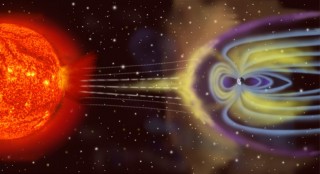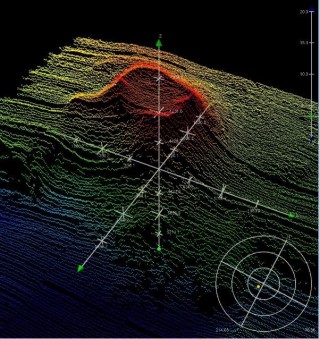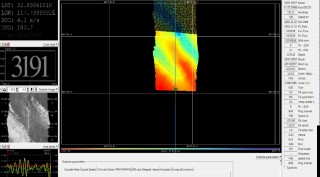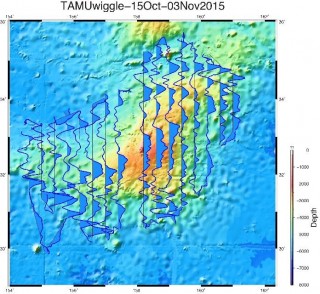

We are currently mapping our last survey line on Tamu Massif, and we will soon be ready to head out.
The planetary Kp index, used to characterize the magnitude of geomagnetic storms, says the magnetic field is a little unsettled. Solar storms are caused by solar protons interacting with geomagnetic field. They usually run down magnetic lines near poles, but can have a worldwide effect. Although we cannot do much about this and we will not know the effects of this magnetic storm on our data, we will acquire the Kakioka (Japanese) magnetic observatory records after the cruise to determine a baseline of what we should have been collecting. The exiting Tamu Massif data are also very important because they record the magnetic anomalies formed just prior to Tamu Massif’s formation. Any data collected after Tamu Massif will be archived for later use by other scientist.
A Step Back

That said, my previous blog stated we are all in the midst of writing reports and compiling data, but what I forgot to mention was that none of us would be here if Chief Scientist Dr. William Sager had not had a passion and interest in geophysics to do the research we are doing. My background and degrees focused primarily on environmental and marine science so understanding exactly what a geophysicist is or does was an opportunity to cross into another world of science I had not previously studied. Maybe we should have defined this in the beginning, but to be honest, understanding his research took some time and a lot of reading throughout the expedition to comprehend what we were doing. Here is a “simple” question I had to begin with as I studied his work. What is geophysics? Sager defines it as using physical properties and relationships of physics to explore things we cannot see, with the ocean bottom being one of those things since it is covered by water. Geophysicists use sound waves to do imaging, magnetic field data to see changes in the magnetic properties, and gravity fields to look at changes in density. Seems pretty simple if defined this way but, as in any science, it’s more complicated.
Understanding the Magnetic Field

As I read through research articles, I found the bathymetric or depth data easy to understand, but the magnetic data posed a little more of a challenge. After weeks aboard R/V Falkor, Dr. Sager explained magnetic fields. The motion in the outer core of Earth leads to magnetic fields which get recorded in the ocean crust. The magnetic field at the Earth’s surface is made up of the following three parts: 1) the core field – created by the liquid outer core, 2) the external field – created in the upper atmosphere by electrical currents, and 3) the crustal field – created by magnetic fields of crustal rocks.
Magnetic Anomalies

In the late 1950’s, scientists mapped the magnetic field over the oceans. When they subtracted the expected magnetic field strength, they found anomalies, values that were higher or lower than expected. These magnetic anomalies are caused by rocks on the floor of the ocean. Volcanic rocks make up the seafloor and are magnetic because as they cool, magnetic minerals within the rock align to the Earth’s magnetic field. Positive magnetic anomalies are places where the magnetic field is stronger than expected because the magnetic field from the crustal rocks enhances the local magnetic field. Positive magnetic anomalies are caused when the rock cools and solidifies with the Earth’s north magnetic pole in the northern geographic hemisphere called “normal polarity.” Negative magnetic anomalies are weaker than expected. Negative magnetic anomalies result when the rock cools and solidifies with the Earth’s north magnetic pole in the southern geographic hemisphere called “reversed polarity.” The resultant magnetic field is less than expected because the Earth’s magnetic field is weakened by the magnetic field of the rock. These zones of opposite magnetic polarity create magnetic anomalies that are hills (zones of normal polarity) and valleys (zones of reversed polarity). This is the data record we are collecting over Tamu Massif using the magnetometer. This information is important because we need to be able to decipher the anomalies over Tamu Massif in order to map the location of the negative and positive anomalies, and assess how they are distributed over Tamu Massif; in turn, furthering our understanding of Tamu Massif’s formation. This may be a mouth full, but knowing the basics is essential to understanding the research being conducted and the reason for being out here for 36 days.

